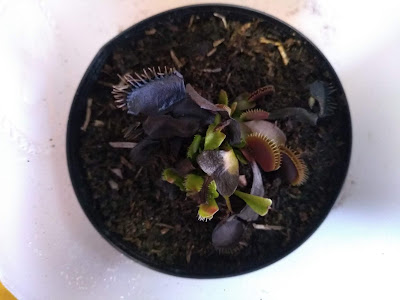To me Wally sounds like the perfect Venus flytrap!
A very generous friend sent me two bare rooted divisions of Wally Venus flytraps. I planted both in the same pot. In hind sight I should have planted them in two different pots instead of the same one.
These plants spent a bit of time in the post, then sat in my letter box all afternoon on one of the hottest days ever recorded in this region before I got home, and they still looked ok.
Venus flytraps tend to handle postage surprisingly well. Notice how good they looked when I planted them!
I figured I should photograph them every now and again to document their growth.
01/02/2020 Minutes after being planted, I should have zoomed in more as the picture probably makes them look smaller than they really were.
 |
| Wally Venus Flytrap - the day I planted them |
11/02/2020 ten days after being planted
14/02/2020 two weeks after planting, they grow fast
 |
| Wally Venus Flytraps - two weeks of growth |
22/02/2020 three weeks
 |
| Wally Venus Flytraps - three weeks after planting |
29/02/2020 four weeks
 |
| Wally Venus Flytraps - four weeks after planting |
I am transitioning my Wally Venus flytraps outside where they get more sun and will be able to go dormant when winter arrives. The traps have coloured up remarkably fast from a little more sunlight.
While they haven't grown massively since the last picture they have gained a lot of colour. I should take another photo soon to show their colour and how much larger they have grown.
28/03/2020 two months
 |
| Wally venus flytrap - more colourful and slightly larger |
 |
| The pictures don't do it justice - the colours are more vibrant in real life |
One morning we went out and when we returned home all of the traps were mysteriously closed. I am not sure if kids came and played with it, but it seems to have recovered well.
04/04/2020 just over 2 months. Today I divided them. One stayed in the original pot, the other is now in a different pot the same size. Wally venus flytraps are just lovely.
Winter isn't too far away and these will go dormant for a while. I can hardly wait to see how large these plants grow next summer. If all goes well I should be able to divide them into more plants in spring.
11/04/2020 - not much growth in a week but look at the colours!!!
02/05/2020 - getting ready for dormancy
01/06/2020 - Wally venus flytrap going dormant
 |
| Wally venus flytrap going dormant |
01/07/2020 - I wish I took photos in July while they were dormant but I didn't. They look dreadful while dormant, which is normal and actually very healthy for venus flytraps.
01/08/2020 - the same plants starting to come out of dormancy. They are small but look strong. As soon as the weather is right I think they will explode with new growth.
29/08/2020 - late winter after surviving frosts, hail, snow, ice, and odd heat
 |
| Breaking dormancy |
 |
| Wally vft clumping |
30/09/2020 - after growing them for 8 months they are breaking dormancy, clumping, sending up flower stalks, and ready to divide
 |
| Sending up a flower stalk. I removed a small division and should divide again |
 |
| The small plant removed from the pot above |
 |
| Wally Venus Flytrap Clumping - I may divide them soon |
01/11/2020 - it is easy to tell which one has been growing inside the house, and which ones have been outside.
 |
| Wally out of dormancy and growing strong |
 |
| Wally vft growing well and colouring up nicely |
 |
| Wally VFT divided and clumping |
01/12/2020 - seems as though I didn't take pictures in December.
02/01/2021 - they are all outside full time in full sun
 |
| Large colourful traps, vigorous growth, Wally vft looking good |
 |
| Wally VFT grow pretty fast |
 |
| One of the divisions seems to have died off, others are looking good |
31/01/2021 one year of growth!
 | |
| All divisions are growing, none had died |
































